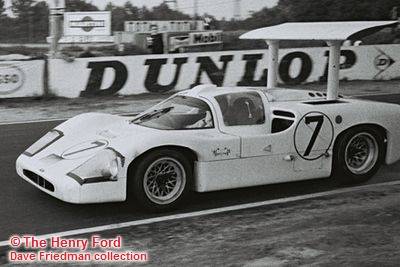 Peu de voitures ont autant capté l’imagination des aficionados du sport automobile que les légendaires Chaparral de Midland, au Texas. Ces Chaparral - possédées et financées par Jim Hall qui travaillait dans le pétrole au Texas – reçurent le soutien technique du service Recherche et Développement de Chevrolet.
Peu de voitures ont autant capté l’imagination des aficionados du sport automobile que les légendaires Chaparral de Midland, au Texas. Ces Chaparral - possédées et financées par Jim Hall qui travaillait dans le pétrole au Texas – reçurent le soutien technique du service Recherche et Développement de Chevrolet.
Une fois qu' Hall et ses relations chez Chevrolet eurent fait des Chaparral blanches les voitures à battre dans le Championnat US et dans la série Can-Am, Hall se tourna vers les courses d’endurance en Europe. Apportant dess innovations comme le châssis en fibre de verre, les transmissions semi-automatiques et les ailerons réglables, Hall vint en France, aux 24 heures du Mans, pour se battre contre toute une armada de Ford GT.
La première participation de l'équipe Chaparral au Mans eut lieu en 1966 avec le coupé Chaparral 2D, propulsé par un V-8 « small block » de 5,3 litres (327 ci) et piloté par Phil Hill, premier champion du monde de Formule 1 américain, et par Jo Bonnier, as des Grands Prix F1. La voiture occupait la dixième place lorsqu’elle fut contrainte à l’abandon au bout de huit heures de course pour un problème de batterie (le règlement du Mans interdit de remplacer une batterie).

L’année suivante, la vénérable 2D fut retirée en faveur de la 2F révolutionnaire, un véritable tour de force technique de la part de Hall.
La 2F était dotée d’un châssis en fibre de verre, d’un V-8 « big block » de 7 litres (427 ci) à injection en aluminium, et d’un aileron arrière révolutionnaire monté assez haut et réglable par le pilote, qui pouvait aller d’une position à faible traînée en ligne droite à une position de fort appui dans les virages. Hill revint au Mans avec Mike Spence comme copilote et tous deux placèrent la 2F deuxième sur la grille de départ. Bruce Jennings et Bob Johnson conduisaient une deuxième Chaparral 2F.

L’équipage Johnson/Jennings perdit du temps lorsque Johnson prit l’échappatoire à Mulsanne, mais Spence, une fois sorti du chaos du départ type Le Mans, prit la tête.
Johnson et Jennings abandonnèrent au bout de 10 heures, tandis que Hill et Spence se trouvaient ralentis, leur aileron étant coincé en position de fort appui.
Alors que Hill était troisième à 5 heures du matin, l’équipage découvrit du liquide de transmission à un arrêt au stand de ravitaillement : il venait d’un joint endommagé.
Trois heures plus tard, la voiture se relançait dans la bataille avec une transmission refaite. Malheureusement, elle fut contrainte à l’abandon au bout de 18 heures de course acharnée : ce fût la dernière Chaparral à courir aux 24 heures du Mans.

1966-67: Chaparral Coupes
Few cars have captured the imagination of motorsports aficionados as completely as the legendary Chaparral race cars from Midland, Texas.
Owned and campaigned by Texas oilman Jim Hall, the Chaparrals enjoyed technical support from Chevrolet R&D. After Hall and his Chevy connections made the white Chaparrals the cars to beat on American soil in the U.S. Road Racing Championship and the unlimited Can-Am series, Hall set his sights on Europe’s classic endurance races.
With innovations such as fiberglass chassis, semi-automatic transmissions and movable wings, Hall went to France to take on an armada of Ford GTs.
Hall’s first foray to Le Mans was in 1967 with the Chaparral 2D coupe powered by a 327ci small-block V-8 and driven by Phil Hill, America’s first Formula One champion, and Grand Prix ace Jo Bonnier. The car qualified 10th and retired after eight hours with a dead battery (Le Mans rules prohibited replacement).
The following year, the venerable 2D was retired in favor of the radical 2F, Hall’s technical tour de force. The 2F sported a fiberglass chassis, a fuel-injected aluminum 427ci big-block V-8, and a driver-operated high-mounted rear wing that could be moved from a low-drag position on the straights to a high-downforce position in corners. Hill returned to Le Mans, teamed with Mike Spence, and the pair qualified the 2F second on the grid. Bruce Jennings and Bob Johnson drove a second Chaparral 2F.
The Johnson/Jennings entry lost time when Johnson opted for the escape road at Mulsanne corner, but Spence took the lead after avoiding the chaos of the Le Mans start. Johnson and Jennings retired after 10 hours, while Hill and Spence were slowed when the wing locked in the high-downforce position. With Hill running third at 5 a.m., the crew spotted transmission fluid during a routine pit stop, the result of a damaged oil seal. Three hours later, the car returned to battle with a rebuilt transmission, but ultimately retired after 18 arduous hours – the last Chaparral to run at Le Mans.

